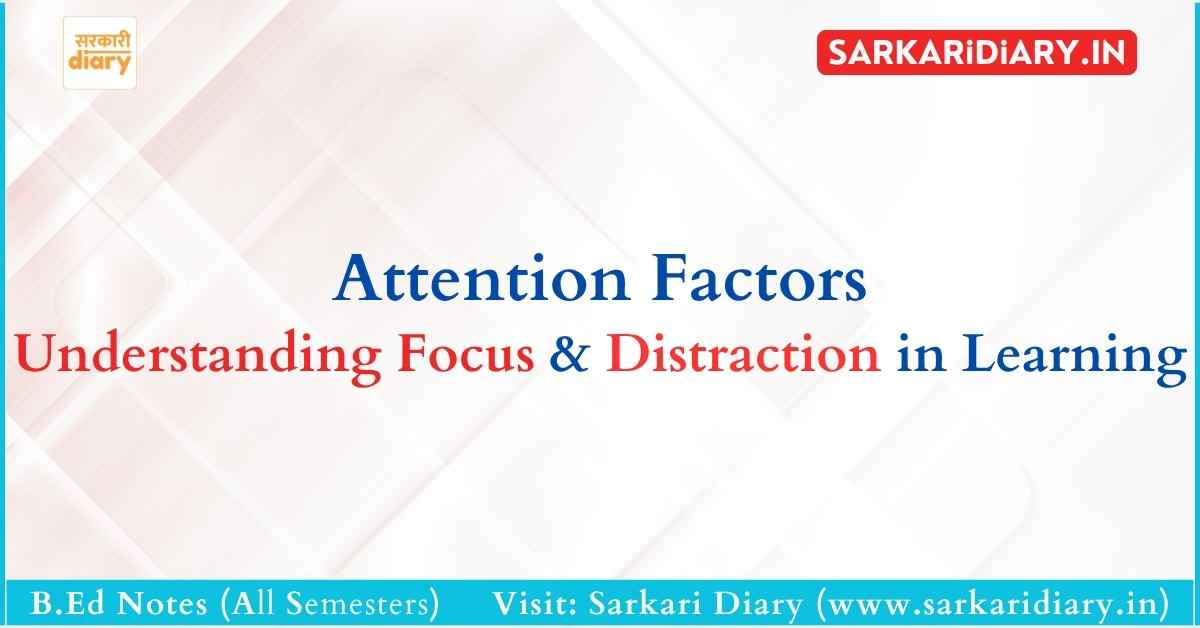Attention Factors: Attention is a vital mental process that allows individuals to selectively concentrate on specific stimuli while ignoring others. It plays a crucial role in learning, memory, and effective communication. However, attention is a complex phenomenon influenced by both internal (subjective) and external (objective) factors.

What is Attention?
While being conscious means being aware of the surroundings, consciousness and attention are not the same. At any given moment, several stimuli may enter our conscious awareness, but only a few receive focused attention.
Attention is the active process of selecting and concentrating on certain stimuli, allowing us to process them deeply.
Types of Attention Factors
| Internal Factors (Subjective) | External Factors (Objective) |
|---|---|
| Personal interests | Novelty or intensity of stimulus |
| Motivation and needs | Movement or change in environment |
| Emotional state | Size, colour, and brightness of objects |
| Level of arousal or fatigue | Relevance or familiarity of the stimulus |
Both sets of factors influence which stimuli capture our attention and how long we can maintain focus.
Span of Attention
The span of attention refers to the number of stimuli or items an individual can focus on simultaneously over a brief period. It represents the capacity of our conscious focus.
Key Points:
- Humans can only attend to a limited number of things at one time.
- For children, all visible stimuli may appear equally noticeable when presented briefly.
- Psychologists measure this span using tools such as the Tachistoscope—a device that flashes images or dots briefly to assess how many elements a person can accurately perceive.
Inattention and Distraction
While attention involves focus, inattention and distraction represent failures or diversions in this process.
Inattention
- Defined as not paying attention to a particular or any stimulus.
- Commonly caused by lack of interest, motivation, or perceived need.
- The absence of internal or external factors needed to engage attention results in inattention.
Distraction
- Refers to shifting attention towards irrelevant stimuli unrelated to the primary task.
- Example: A student may try to focus on a lecture but gets distracted by noises from outside the classroom.
- Distraction leads to reduced productivity, increased mental fatigue, and energy wastage.
Summary Table: Attention, Inattention, and Distraction
| Term | Meaning | Causes | Effects |
|---|---|---|---|
| Attention | Focusing on relevant stimuli | Internal motivation, stimulus properties | Enhanced learning and performance |
| Inattention | Failure to focus on stimuli | Lack of interest or motivation | Poor comprehension and learning |
| Distraction | Shift of focus to irrelevant stimuli | External noise, irrelevant stimuli | Decreased productivity and fatigue |
Concept Formation Types
Concept refers to a generalised idea or mental image representing a group of objects, events, or phenomena sharing common characteristics. Concepts help us organise experiences and understand the world around us.
Classification of Concepts
Concepts can be broadly classified as follows:
| Category | Description | Examples |
|---|---|---|
| Simple Concept | Based on a single attribute or quality. | Green, tall, square, triangle |
| Complex Concept | Involves multiple attributes or characteristics. | Car (mode of transport, fuel type, number of wheels), democracy, marriage |
| Concept of Object | Concepts related to tangible objects. | Book, house, car |
| Concept of Aspects | Divided into: | |
| – Qualitative: Related to properties or qualities. | Honesty, simplicity, smoothness | |
| – Relational: Defined by relationships between objects or qualities. | Bigger than, taller than, faster than | |
| Imaginary Concept | Concepts of abstract or non-physical entities, often hypothetical or imaginative. | Heaven, hell, atom, milky way, photons, golden mountain |
Conclusion
Attention is a selective and dynamic process crucial for effective learning and cognitive functioning. Recognising the factors that influence attention, as well as the causes of inattention and distraction, helps educators create optimal learning environments. By minimising distractions and fostering intrinsic motivation, teachers can significantly enhance students’ ability to concentrate and learn efficiently.